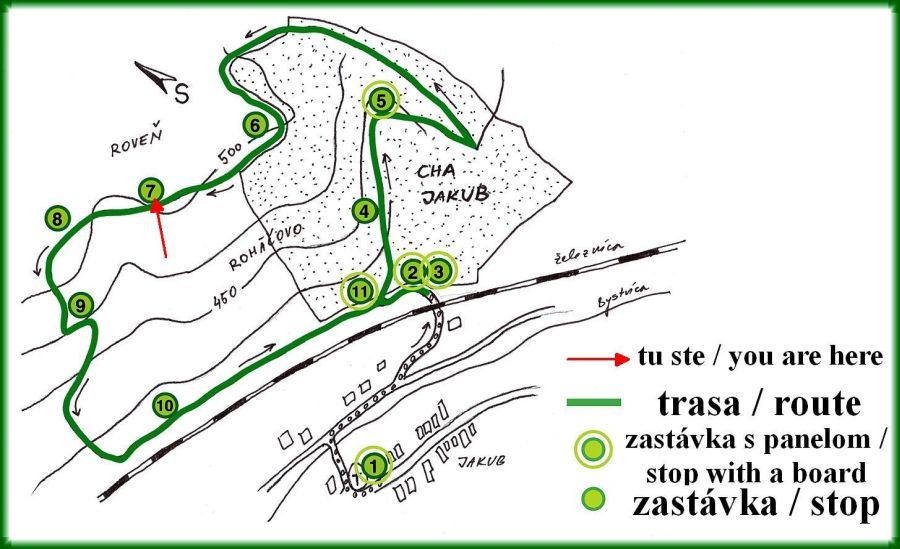
ZASTÁVKA SIEDMA – POZORUJEME VTÁCTVO
Lúky, kroviny, osamelé stromy, či les, všetky tieto prostredia poskytujú dostatok potravy a úkrytov rôznym druhom vtákov. Škovránok poľný (Alauda arvensis), pŕhľaviar čiernohlavý (Saxicola torquata), či strnádka žltá (Emberia citrinella) si svoje hniezda budujú na lúkach priamo na zemi. Často sú dobre ukryté v zemnej priehlbine pod prevísajúcou trávou.
V okolitých krovinách zas s obľubou hniezdia strakoš červenochrbtý (Lanius collurio) a penica hnedokrídla (Sylvia communis). Obidva druhy sa živia hmyzom, strakoše však dokážu uloviť aj dospelého hraboša, či jaštericu. Prítomnosť strakoša prezrádzajú tiež na tŕňoch kríkov nabodnuté prebytky potravy.
V skupine kríkov so stromami môžeme obdivovať čistý nápev penice čiernohlavej (Sylvia atricapilla), či flautový spev drozda čierneho (Turdus merula). Spev slúži nielen na prilákanie samičky, ale tiež na označenie teritória. Teritórium predstavuje určitý revír, v ktorom vtáčia rodina loví a bráni si ho pred ostatnými jedincami svojho druhu. Naproti tomu iné druhy, ktoré nepredstavujú konkurenciu v potrave sú v teritóriu tolerované.
Na osamelých, alebo v skupinách stojacich stromoch si stavajú hniezda vrany túlavé (Corvus corone) a straky čiernozobé (Pica pica). Sú to mimoriadne prispôsobivé vtáky. Sú schopné žiť aj v človekom silne pozmenenej krajine, napr. v blízkosti frekventovaných ciest. Opustené hniezda vrán a strák využívajú myšiarky ušaté (Asio otus) a sokoly myšiare (Falco tinnunculus), ktoré si vlastné hniezda nestavajú. Oba druhy sa živia najmä myšami a hrabošmi, svoju potravu si však v letnom období spestrujú aj hmyzom. Tak ako všetky druhy našich dravcov a sov sú zaradené v zozname chránených druhov živočíchov Slovenska.
Ďalším vtákom, ktorého možno vidieť v okolí náučného chodníka, a ktorého obydlia s obľubou využívajú aj iné druhy vtákov je ďateľ veľký (Dendrocopos major). Ďatle si na každé hniezdenie robia novú dutinu v nahnitom dreve. Uvoľnené dutiny obsadzujú drobné vtáky, najmä sýkorky. Sýkorka sa živia hlavne hmyzom, denne skonzumujú viac než polovicu svojej hmotnosti. Ako u všetkých drobných vtákov, postupuje u nich látková výmena veľmi rýchlo, takže sú vlastne stále hladné. Jedna rodinka sýkoriek dokáže zozbierať za rok až 75 kg hmyzu.
V okolitých krovinách zas s obľubou hniezdia strakoš červenochrbtý (Lanius collurio) a penica hnedokrídla (Sylvia communis). Obidva druhy sa živia hmyzom, strakoše však dokážu uloviť aj dospelého hraboša, či jaštericu. Prítomnosť strakoša prezrádzajú tiež na tŕňoch kríkov nabodnuté prebytky potravy.
V skupine kríkov so stromami môžeme obdivovať čistý nápev penice čiernohlavej (Sylvia atricapilla), či flautový spev drozda čierneho (Turdus merula). Spev slúži nielen na prilákanie samičky, ale tiež na označenie teritória. Teritórium predstavuje určitý revír, v ktorom vtáčia rodina loví a bráni si ho pred ostatnými jedincami svojho druhu. Naproti tomu iné druhy, ktoré nepredstavujú konkurenciu v potrave sú v teritóriu tolerované.
Na osamelých, alebo v skupinách stojacich stromoch si stavajú hniezda vrany túlavé (Corvus corone) a straky čiernozobé (Pica pica). Sú to mimoriadne prispôsobivé vtáky. Sú schopné žiť aj v človekom silne pozmenenej krajine, napr. v blízkosti frekventovaných ciest. Opustené hniezda vrán a strák využívajú myšiarky ušaté (Asio otus) a sokoly myšiare (Falco tinnunculus), ktoré si vlastné hniezda nestavajú. Oba druhy sa živia najmä myšami a hrabošmi, svoju potravu si však v letnom období spestrujú aj hmyzom. Tak ako všetky druhy našich dravcov a sov sú zaradené v zozname chránených druhov živočíchov Slovenska.
Ďalším vtákom, ktorého možno vidieť v okolí náučného chodníka, a ktorého obydlia s obľubou využívajú aj iné druhy vtákov je ďateľ veľký (Dendrocopos major). Ďatle si na každé hniezdenie robia novú dutinu v nahnitom dreve. Uvoľnené dutiny obsadzujú drobné vtáky, najmä sýkorky. Sýkorka sa živia hlavne hmyzom, denne skonzumujú viac než polovicu svojej hmotnosti. Ako u všetkých drobných vtákov, postupuje u nich látková výmena veľmi rýchlo, takže sú vlastne stále hladné. Jedna rodinka sýkoriek dokáže zozbierať za rok až 75 kg hmyzu.
SEVENTH STOP – BIRD WATCHING
Grasslands, bushes, solitary trees or forests, each of these environments offer enough food and hiding places for various bird species. The Eurasian skylark (Alauda arvensis), Common stonechat (Saxicola torquata) or Yellowhammer (Emberiza citronella) build their nests on the ground in the grasslands. They are often well-hidden in depressions under the grass.
In the surrounding bushes are nesting Red-backed shrike (Lanius colluio) and Common whitethroat (Sylvia communis). Both of them feed on insects, shrikes can catch a vole or a lizard. Impaled food on the thorns of the bushes shows the presence of a shrike.
In the bushes, we can admire singing of the Eurasian blackcap (Sylvia atricapilla) or a fluted warble of the Eurasian blackbird (Turdus merula). Singing is used for attracting a female, but also for marking the territory. Territory is a district, where the birds are hunting and which they are protecting from other individuals of their kind. However, other species, which are not a competition for them are tolerated in the territory.
On the solitary trees or in the group of trees are nesting the Carrion Crow (Corvus corone) and the Eurasian magpie (Pica pica). They are particularly adaptable birds. They are able to live in a land heavily modified by human activities, for example near busy roads. Abandoned nest of crows and magpies are used by Long-eared owl (Asio otus) and European kestrel (Falco tinnunculus) that are not building their own nests. Both species feed mainly on mice and voles, in summer months also on insects. Same as other species of prey birds and owls, they are in the List of protected animal species of Slovakia.
Another bird, which can be seen in the area and whose nests are used by other bird species, is Great spotted woodpecker (Dendrocopos major). Woodpeckers make for every nesting a new hollow in a decaying wood. Empty hollows are then occupied by smaller birds, mainly by tits. Tits are feed on insects, daily they eat more than a half of their weight. Like all small bird species, they have fast metabolism, so they are actually always hungry. One family of tits can eat 75 kilograms of insects every year.
In the surrounding bushes are nesting Red-backed shrike (Lanius colluio) and Common whitethroat (Sylvia communis). Both of them feed on insects, shrikes can catch a vole or a lizard. Impaled food on the thorns of the bushes shows the presence of a shrike.
In the bushes, we can admire singing of the Eurasian blackcap (Sylvia atricapilla) or a fluted warble of the Eurasian blackbird (Turdus merula). Singing is used for attracting a female, but also for marking the territory. Territory is a district, where the birds are hunting and which they are protecting from other individuals of their kind. However, other species, which are not a competition for them are tolerated in the territory.
On the solitary trees or in the group of trees are nesting the Carrion Crow (Corvus corone) and the Eurasian magpie (Pica pica). They are particularly adaptable birds. They are able to live in a land heavily modified by human activities, for example near busy roads. Abandoned nest of crows and magpies are used by Long-eared owl (Asio otus) and European kestrel (Falco tinnunculus) that are not building their own nests. Both species feed mainly on mice and voles, in summer months also on insects. Same as other species of prey birds and owls, they are in the List of protected animal species of Slovakia.
Another bird, which can be seen in the area and whose nests are used by other bird species, is Great spotted woodpecker (Dendrocopos major). Woodpeckers make for every nesting a new hollow in a decaying wood. Empty hollows are then occupied by smaller birds, mainly by tits. Tits are feed on insects, daily they eat more than a half of their weight. Like all small bird species, they have fast metabolism, so they are actually always hungry. One family of tits can eat 75 kilograms of insects every year.
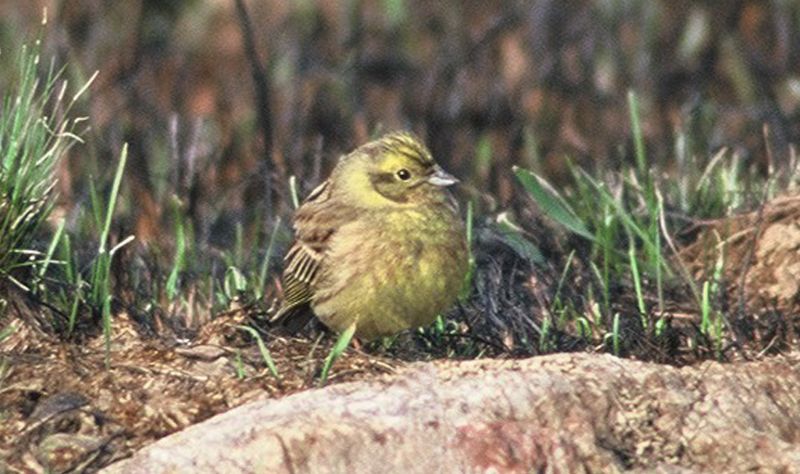
Strnádka žltá / Yellowhammer Foto: Gabriel Demeter
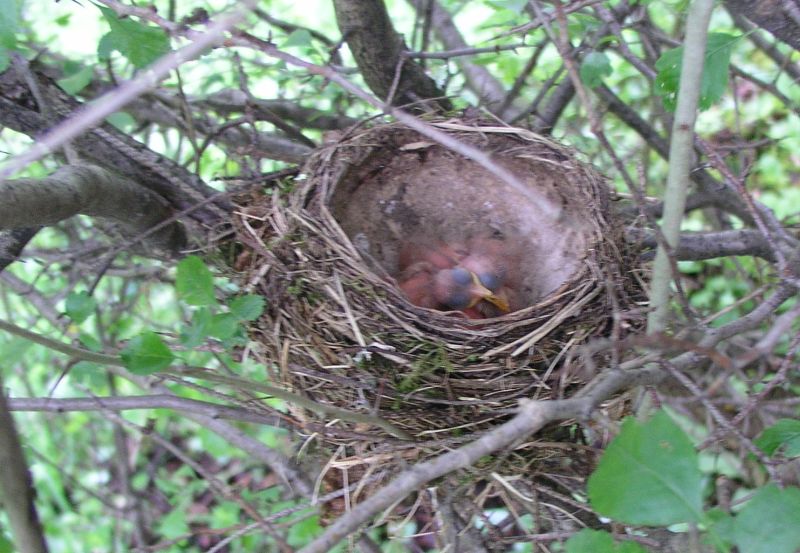
Hniezdo drozda čierneho / Nest of a blackbird Foto: Dušan Šácha
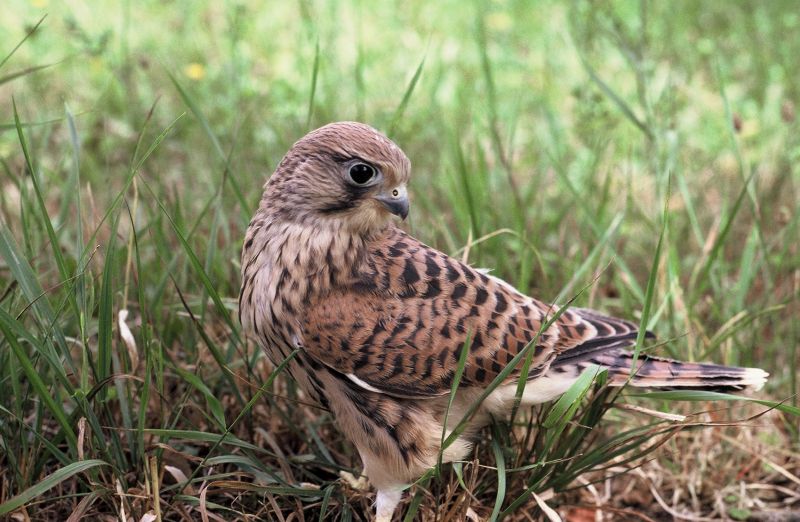
Sokol myšiar / European kestrel Foto: Gabriel Demeter
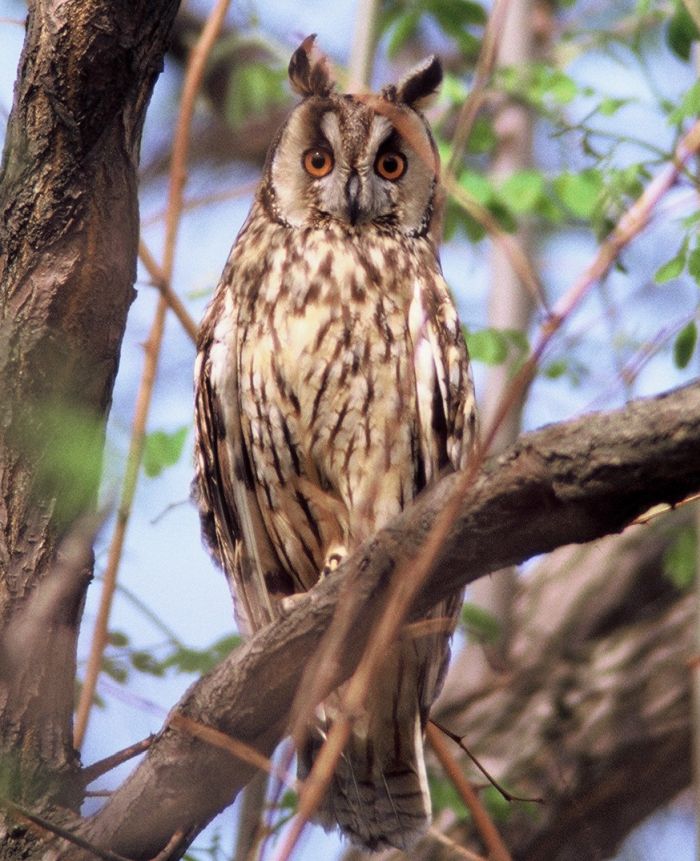
Myšiarka ušatá / Long-eared owl Foto: Gabriel Demeter
